The Epic Saga of AW-4 Control…
RADesigns Products LLC Rail Shifter Install
by Tim Doumit – March 17, 2011
A couple of years ago I followed my pal Stu Olson into the dark side where they issued gold toes for those who dare to go where no TJ owner had before… The XJ AW-4 Swap.
It’s not really dark there, kind of silvery and wiry with some red fluidy stuff and other dirty stuff that somehow always gets in your eyes even though you always wear safety glasses…
Stu was kind enough to put my AW-4 write-up with his on his wonderful jeep site. Mine was written to be used in conjunction with Stu’s and should be viewed likewise. That is… if you choose to follow along with what I have done.
Anyways, after I installed the AW-4, the first thing that I should have done was install some sort of manual control. This is important for the off-road community, at least the part that does not like how the AW-4 shifts into second gear at exactly at the wrong point creating tension, screaming and uncontrollable urination of Jeep occupants (except driver of course). If there was one downfall to the AW-4’s existence it would be the 2-1 location on the shifter.
Here is the remedy.
AWShifter was still available for a short time during my AW-4 swap. Within a month of this time it was no longer possible to buy one. Two years later, I was reminded that there was another type of manual shifter available from RADesigns Products LLC. Actually they have a couple different models for the AW-4 type transmission.
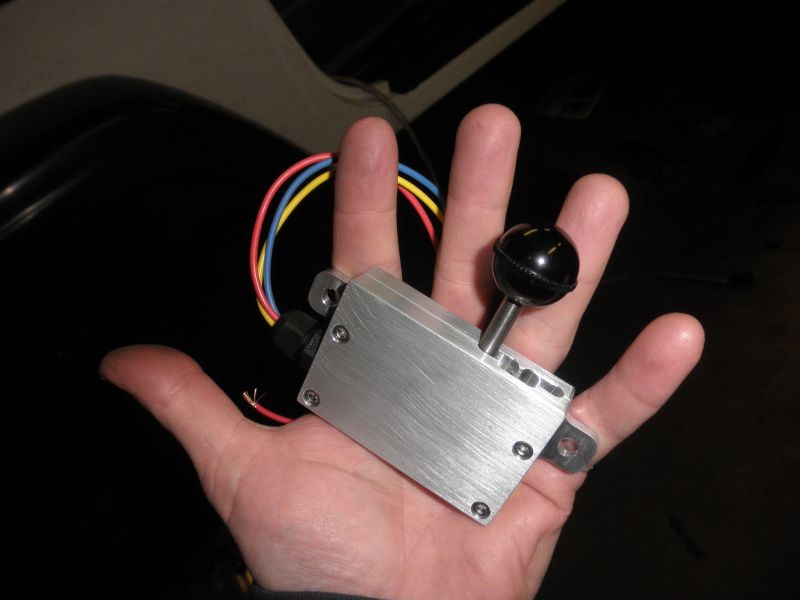
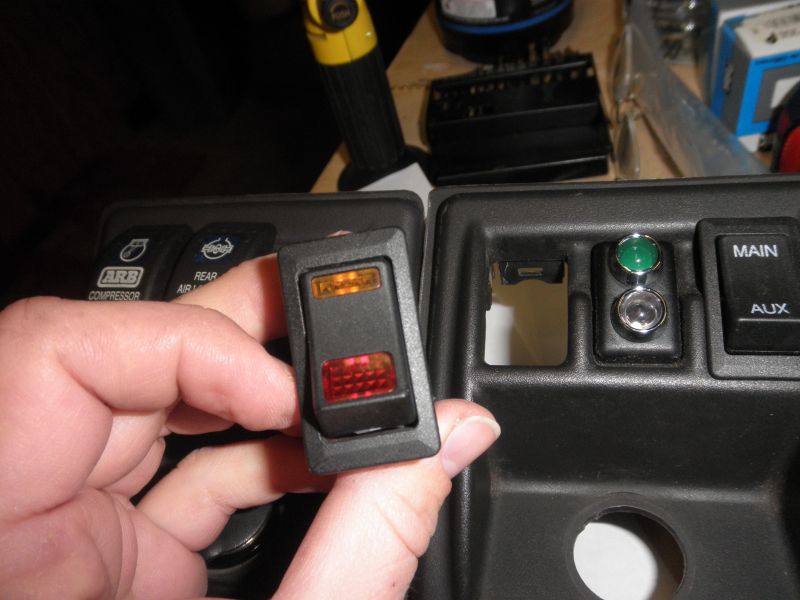
Let’s start with the Rail Shifter / TCU control switch: I like Pollak Switches. For this application I used Pollak # 34-359 on/on rocker switch. The reason that I use Pollak switches is very important to me; they are made in the United States of America (and they seem to be of high quality).
Back to the switches… Let us call it the “Control Switch’.
The control switch comes with the words “MAIN” and “AUX” stenciled on them. My choice was to use MAIN for normal operations, using the TCU to control the AW-4 and AUX for the times when I want to use the Rail Shifter.
Indicator lights: I used Pico brand indicators, BLUE for solenoid#1 and GREEN for solenoid #2. These are located in between the Control switch (right) and the Torque Converter lock-up switch on the left. The indicators are not LEDs, however they are very intense. Fortunately they are installed below eye level in the Age old “dual switch panel modification” that has been chronicled many times all over the internet. If you do the panel mod, I suggest finding a few good write-ups first and a Dremel tool.
While driving the indicators function as followed:
1st gear – GREEN
2nd gear – GREEN/BLUE
3rd gear – BLUE
4th gear – NONE
The Torque Converter Lock-up Switch: Also made in the U.S.A. It is an on/off/on switch made by Cole Hersee Co. or CH (I do not have a part number for this switch). It is illuminated with RED or AMBER windows. Looking back, I would have used a plain black rocker instead of this illuminated switch as the angle of view is incorrect plus, in order to make the lights work correctly relays were needed. Relays are never a bad idea. I always use CH relays part# (RA-400112-DN)
The Torque Converter Lock-up switch functions as follows:
Top position – Normal operations
Middle position – Off
Bottom position – Lock-up
From what I understand, the torque converter lock-up should be used mostly on the street and never in lower gear ranges. It can add mileage to your gas consumption and help your transmission stay cooler while helping with engine braking. Maybe Stu will comment here :o)
<Stu’s comments> In my opinion, you should not lock the torque converter off-road. When I was doing my install, I spoke with a tranny mechanic. He informed me that the torque converter clutch pack is very small and can not handle the torque found in those lower gears when off-roading. In fact, if you think about it, an auto tranny will unlock the torque converter when the vehicle gets on a steep uphill stretch of highway. It does this to save the clutches and to help prevent the engine from bogging down. Once back on a level stretch of road, the computer locks the converter to reduce slippage (this equates to heat loss) and improve mileage. </ Stu’s comments>
Both rocker switches with the tops depressed is “normal operation mode”.
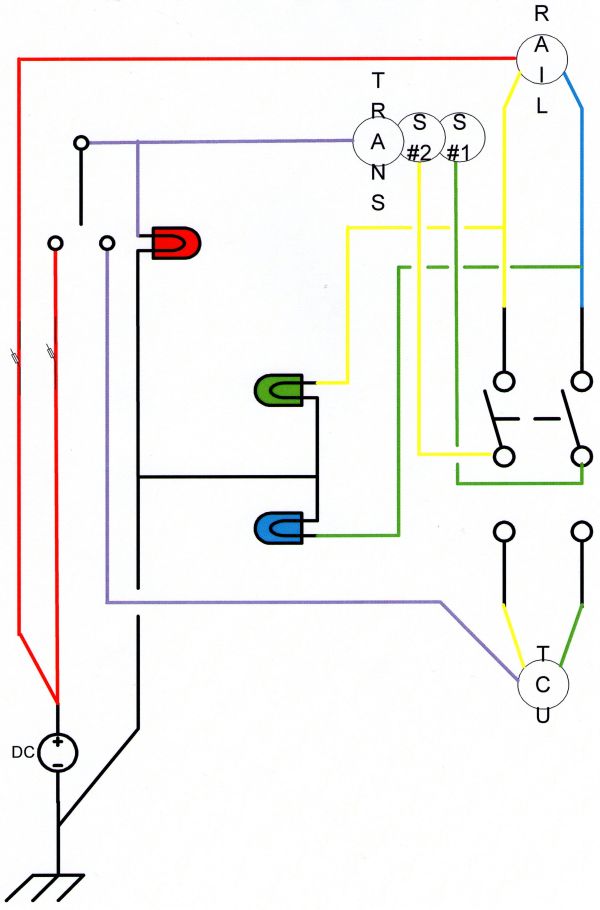
Above is something I worked out after drawing descriptions of what should “work”. I found that there were many who wanted to lend a hand on wiring help but every time something was left out to confuse or baffle me. Stu offered some very useful tips. mrblaine suggested putting it all down on paper (we were on another subject at the time). tjeeper described what he did. RADesigns instructions were worded sort of funny and the diagrams did not load properly for me until I emailed .jpegs of them to my work and blew them up. Still, his diagrams need more work. All contributions were of help.
The Transmission leads plug into the center pins. TCU go on one end. Rail Shifter on the other. Even a caveman could do it… Although it took this troglodyte a while to club his way through it.
On the Torque converter lock-up, I show a indicator light which is not installed. This may come later as I think it would be useful to have a reminder of what is going on at any certain time.
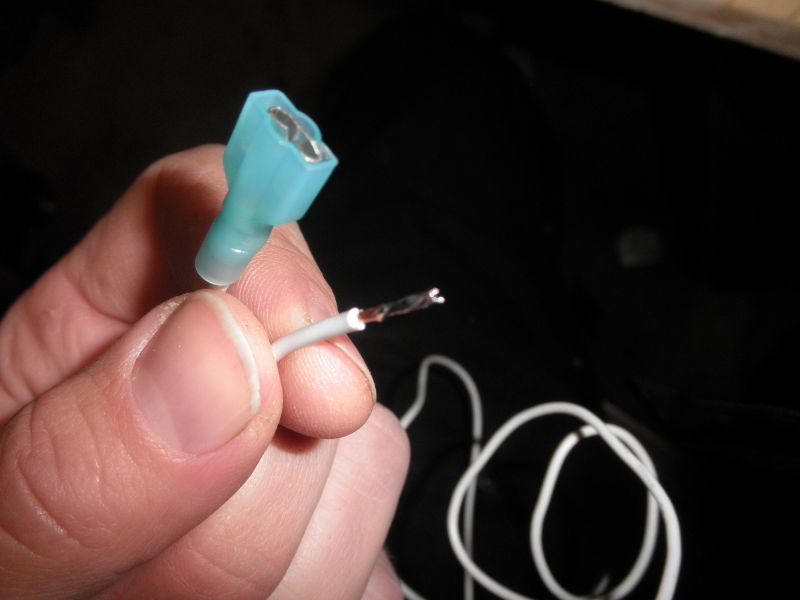
Ordinarily I will buy unshielded connectors to go onto the switches I install. I will pull off the little blue plastic collar, pierce/crimp the connector, solder it and heat shrink it with Phillips water tight version. OCD… I know…
This time I decided to just go with shielded connectors behind the switches which meant tinning the ends of each wire. Why do I do this? Look at the last paragraph… And, it keeps the connector from slipping off the wire by creating a firm place to crimp to. This is important if you would like to remove the wires from the switch as these switches sort of lock onto the connectors better than anything made in China that you will find in a aisle at the chain auto parts store.
RADesigns Rail Shifter for the AW-4

If you decide you would like to go with an illuminated switch for your install, this is what you will need. It adds about $30.00 to the project. All in the name of Bling… Please look at the colored pencil drawing as this is what I did and it seems to be working just fine. (I did not notice this before but the light pencil drawing is “something else” and should be ignored as it is not even for a jeep project.)
There are many illustrations on how to wire relays on the internet if you don’t know exactly what to do.
Pin-out note for 2000 XJ TCU plug:
Pin #11- dark blue/white stripe – torque converter
Pin #12 – white – “solenoid A”
Pin #13 – orange/white stripe “solenoid B”
(I use a 2000 XJ description here.)
NOTE: make sure your TCU is mounted / grounded to the tub when testing and troubleshooting. Fuse protect all +12 volt lines.
Rail Shifter / Console Install:
Normally I don’t want to be like everyone else and do the exact same thing. Usually it would be the smart thing to do as a beaten path is certainly easy to follow. Some of you may know me and my Jeep and how I feel about it:
1 – It must be highly functional in almost any situation on or off-road.
2 – It must be extremely reliable.
3 – It must look slick…
There is only duct tape for getting home… There shall not be duct tape for going “there” only for getting “back”…
High Zoot double sided 3M tape is another story!
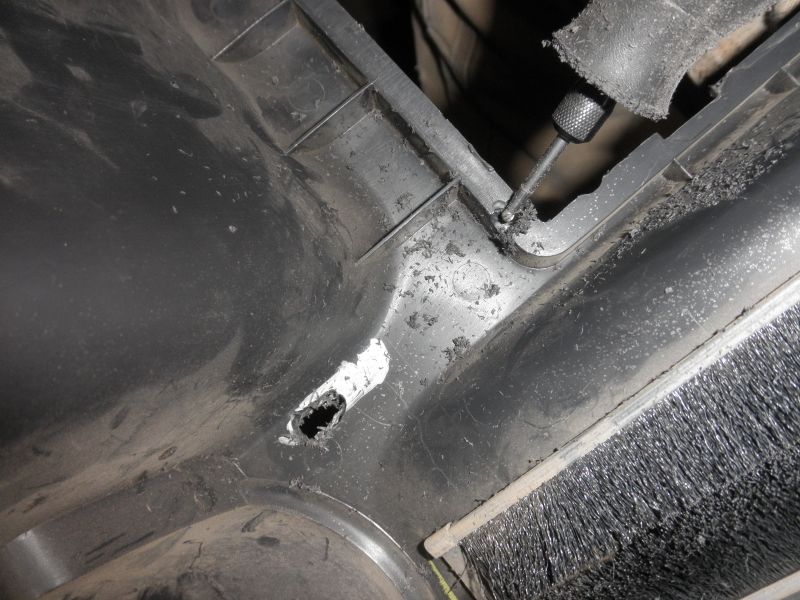
I wanted to place the Rail Shifter in the console and not scabbed to the side of something with overflowing epoxy and rusty slot head bolts. The Dremel tool came in handy here and some eyeball guess work did too.

Using 3M tape and one 1/4-20 button top stainless bolt with a spacer, the Rail Shifter was firmly secured into the console. It took some test fitting to get it in there but it went nicely.
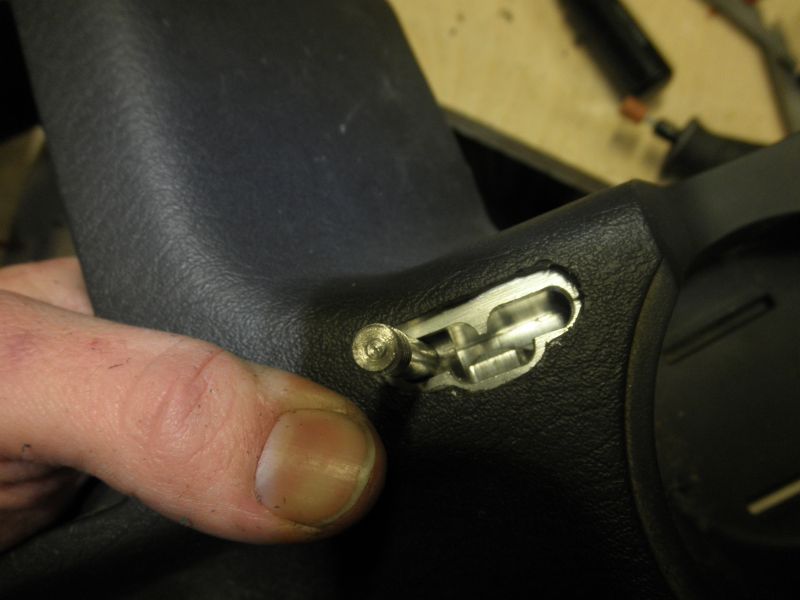
Top view while fitting it together. Careful you don’t take the shaft out of the unit. I think it would be hard to get back in if the larger shaft rotated, so take the ball off instead.
The top of the shifter housing will see grey paint to match the console. (OCD… yup)
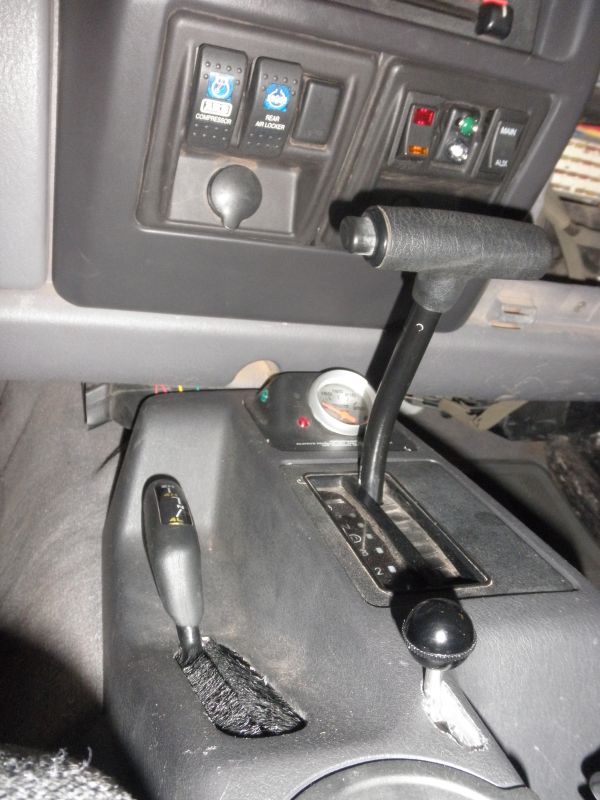
Here it is all buttoned up…..and with some conduit and wire ties, it will be done.
Ending note:
This addition was not too difficult. If you have the cojones to swap in the AW-4 then you will have no problem figuring this out. Hopefully you have a AW-4 swap book compiled like me (which I put together as I did the initial swap).
The XJ reference materials were helpful to show pin-outs on the TCU plug. My new drawings helped make it possible too. I highly suggest putting it all down on paper first as this is a worth while step. Plus you get to color!
For safety reasons as mentioned to me by tjeeper: Rest the Rail Shifter in 4th (forward position) when not in use just incase someone bumps a switch at highway speeds. Slamming into first would not be well accepted by the occupants. And, be careful with the torque converter lock-up.
Educate yourself about what you are going to do… as any modification you make you your Jeep is YOUR decision, YOUR credit, YOUR mistake or fault… By Doing this modification only you and no one else can accept the responsibility that goes along with it.
And finally…
My 97 Jeep TJ started out in May 5 1996 as a shiny new, white pavement pounding, gravel flinging fun machine. Aside from the first three or so months of the TJs production being “different and unique”, it has seen many modifications during many different phases. I don’t even remember them all. There may be several things that have been done to my Jeep that may make an install different on my Jeep than any other as it has: Ford, Chevy, Buick, Volvo and Jeep parts on it including every year of TJ… Cherokee parts, FSJ parts…. Just so no one compares their shiny apple to my speckled banana…
Jeep on!
Tim :o)
Update: 05/05/2011 – (from Tim) Here is a little post Moab, UT update for the Rail Shifter…..
First of all, I want to say that this does just what it says it’s going to do. Second, is a lesson in dexterity…
Okay, here is kind of how this works in my TJ:
Manual Control:
(AW-4 transmission shifter position is noted first in each line)
- DRIVE position: not true manual control during compression braking as transmission still wants to shift “out”. This is just fine as long as you are on level ground (or going up a hill, ledge, etc…) and not descending a steep ledge or grade in low range.
- 1 – 2 position: transmission will lock in 1st or 2nd gear and compression braking is now possible.
- 3 position: transmission can be shifted between 1st, 2nd and 3rd. Don’t expect the transmission to stay in 1st gear
- REVERSE: operates normally
Personal Problems:
- Getting used to the controls
- Remembering to shift
- What gear am I in??? (this is what the lights are for)
- Extra busywork
I find that the Rail Shifter needs to be in 4th when the transmission is in “AUTO”. Otherwise it does not shift right. It is quite possible this is my doing but I look at it as a safe guard against accidentally going “MANUAL” at speed and slamming into 1st… Park the Rail Shifter in 4th when in “AUTO”.
Install Notes:
Make sure you can operate everything in each shift position. I mean, if the transmission is in 1-2 and it’s hitting the Rail Shifter… not good.
Dry graphite lube is probably needed for the rail shifter.
Mine had enough clearance and it’s controls are bundled in the same area. This is convenient and difficult at the same time and is something that I have to get used to. It will work perfectly fine as soon as I become “one” with the controls.
First Wheeling Impressions:
I am Happy with the fact that I can now select 1st gear and know that it will stay put. I feel that total manual control is not needed as long as I can have 1st gear. This controller is most likely overkill for what I need but I like the idea of control if the TCU poops out.
I wheeled both with the Rail Shifter and Auto control; I prefer the Rail off road and Auto on road although the Rail Shifter was nice on road in a hilly section south of Moab when the transmission wanted to “hunt”.
Options are always nice to have, especially when compression braking down something like the Dragons Tail on Hell’s Revenge!
